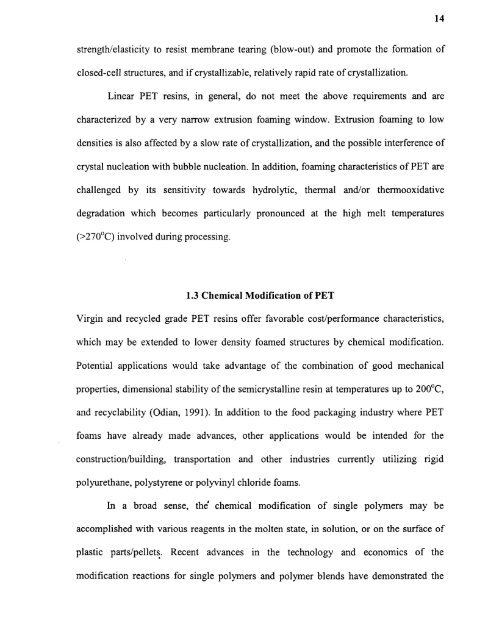A reactive melt modification of polyethylene terephthalate
A reactive melt modification of polyethylene terephthalate
A reactive melt modification of polyethylene terephthalate
Create successful ePaper yourself
Turn your PDF publications into a flip-book with our unique Google optimized e-Paper software.
14<br />
strength/elasticity to resist membrane tearing (blow-out) and promote the formation <strong>of</strong><br />
closed-cell structures, and if crystallizable, relatively rapid rate <strong>of</strong> crystallization.<br />
Linear PET resins, in general, do not meet the above requirements and are<br />
characterized by a very narrow extrusion foaming window. Extrusion foaming to low<br />
densities is also affected by a slow rate <strong>of</strong> crystallization, and the possible interference <strong>of</strong><br />
crystal nucleation with bubble nucleation. In addition, foaming characteristics <strong>of</strong> PET are<br />
challenged by its sensitivity towards hydrolytic, thermal and/or thermooxidative<br />
degradation which becomes particularly pronounced at the high <strong>melt</strong> temperatures<br />
(>270°C) involved during processing.<br />
1.3 Chemical Modification <strong>of</strong> PET<br />
Virgin and recycled grade PET resins <strong>of</strong>fer favorable cost/performance characteristics,<br />
which may be extended to lower density foamed structures by chemical <strong>modification</strong>.<br />
Potential applications would take advantage <strong>of</strong> the combination <strong>of</strong> good mechanical<br />
properties, dimensional stability <strong>of</strong> the semicrystalline resin at temperatures up to 200 °C,<br />
and recyclability (Odian, 1991). In addition to the food packaging industry where PET<br />
foams have already made advances, other applications would be intended for the<br />
construction/building, transportation and other industries currently utilizing rigid<br />
polyurethane, polystyrene or polyvinyl chloride foams.<br />
In a broad sense, the chemical <strong>modification</strong> <strong>of</strong> single polymers may be<br />
accomplished with various reagents in the molten state, in solution, or on the surface <strong>of</strong><br />
plastic parts/pellets. Recent advances in the technology and economics <strong>of</strong> the<br />
<strong>modification</strong> reactions for single polymers and polymer blends have demonstrated the

















